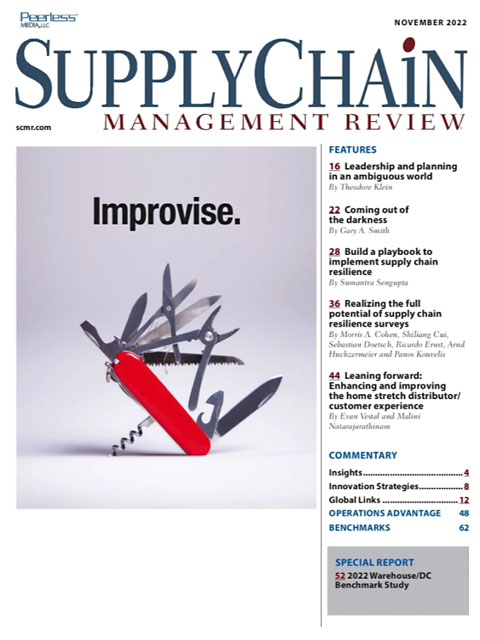Sorry, but your login has failed. Please recheck your login information and resubmit. If your subscription has expired, renew here.
November 2022
Are you resilient? It’s not an idle question. If there’s one word that I’ve heard at every supply chain event I’ve attended this year, its resilience. It is, of course, in response to the last few years in supply chain management. I think its fair to say that supply chains have been knocked to the canvas more times than Rocky. What has become clear as we do our post-pandemic reviews is that the firms that demonstrated the ability to get up off the canvas and keep punching were those that invested in resiliency before the pandemic—even if they didn’t use that term. Browse this issue archive.Need Help? Contact customer service 847-559-7581 More options
Shippers continue to experience significant supply chain and margin pressures as the rise of e-commerce, accelerated by the pandemic, disrupts fulfillment models across a broad range of product categories.
Direct-to-consumer (DTC) demand remains strong despite 8% inflation and recession concerns; U.S. e-commerce sales are expected to top $1 trillion for the first time this year, even as the overall growth rate will likely slow to 9.4% YoY for 2022, according to Insider Intelligence. The longer-term trend, meanwhile, is upward, with online sales expected to reach $1.67 trillion by 2026, or 21.2% of total U.S. retail sales.
Customer expectations regarding delivery speed such as next-day and sub-same day delivery, quality, cost and reliability have continued to rise. Same-day delivery, for example, will likely grow by 21% annually through 2024; mostly free returns, accounting for 15% to 30% of online purchases—double that of conventional retail—totaled $114 billion during the 2021 holiday peak period alone. Customers are unforgiving: a consistent 40% tell surveys that they disregard shippers that don’t offer free shipping or return options, and more than 80% never return to a site after a single delivery failure.
Meanwhile, costs are rising dramatically due to skyrocketing labor, fuel, returns and facilities investments to be closer to customers, in both dense urban and underserved rural locations. For example, rapidly rising market cost impacts are reflected in steady two-year increases of 7% to 9% in parcel freight rates. For many shippers, today’s rapid changes in customer demands and operating costs have resulted in eroded margins, stunted growth and an uncertain future path forward.

This complete article is available to subscribers only.
Log in now for full access or start your PLUS+ subscription for instant access.
SC
MR
Sorry, but your login has failed. Please recheck your login information and resubmit. If your subscription has expired, renew here.
November 2022
Are you resilient? It’s not an idle question. If there’s one word that I’ve heard at every supply chain event I’ve attended this year, its resilience. It is, of course, in response to the last few years in… Browse this issue archive. Access your online digital edition. Download a PDF file of the November 2022 issue.Shippers continue to experience significant supply chain and margin pressures as the rise of e-commerce, accelerated by the pandemic, disrupts fulfillment models across a broad range of product categories.
Direct-to-consumer (DTC) demand remains strong despite 8% inflation and recession concerns; U.S. e-commerce sales are expected to top $1 trillion for the first time this year, even as the overall growth rate will likely slow to 9.4% YoY for 2022, according to Insider Intelligence. The longer-term trend, meanwhile, is upward, with online sales expected to reach $1.67 trillion by 2026, or 21.2% of total U.S. retail sales.
Customer expectations regarding delivery speed such as next-day and sub-same day delivery, quality, cost and reliability have continued to rise. Same-day delivery, for example, will likely grow by 21% annually through 2024; mostly free returns, accounting for 15% to 30% of online purchases—double that of conventional retail—totaled $114 billion during the 2021 holiday peak period alone. Customers are unforgiving: a consistent 40% tell surveys that they disregard shippers that don’t offer free shipping or return options, and more than 80% never return to a site after a single delivery failure.
Meanwhile, costs are rising dramatically due to skyrocketing labor, fuel, returns and facilities investments to be closer to customers, in both dense urban and underserved rural locations. For example, rapidly rising market cost impacts are reflected in steady two-year increases of 7% to 9% in parcel freight rates. For many shippers, today’s rapid changes in customer demands and operating costs have resulted in eroded margins, stunted growth and an uncertain future path forward.
SC
MR


Latest Supply Chain News
Latest Podcast

 Explore
Explore
Business Management News
- 2024 Warehouse/DC Operations Survey: Technology adoption on the rise
- Benchmarking the complexity of ESG reporting
- Looking back at NextGen 2024
- The Corporate Sustainability Due Diligence Directive
- How to make your CFO a supply chain superfan
- Manufacturing again contracts in October, reports ISM
- More Business Management
Latest Business Management Resources

Subscribe

Supply Chain Management Review delivers the best industry content.

Editors’ Picks





